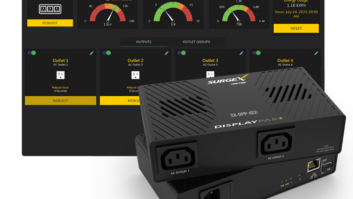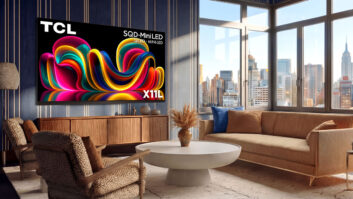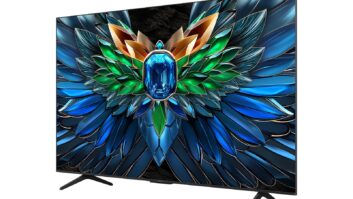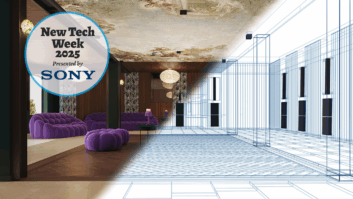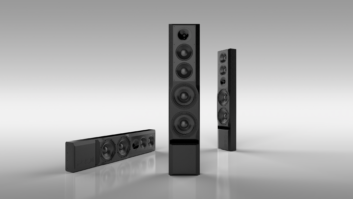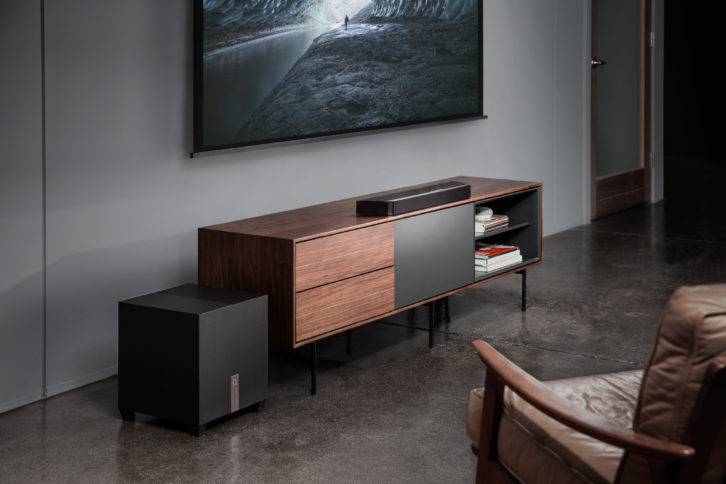
My first “real” home theater purchase was a Definitive Technology subwoofer back in 1995. It was a PowerField 15; basically, a big, plain, black cube with a 15-inch driver that I drove into San Francisco to buy from the nearest dealer after researching every review I could get my hands on. (A far more difficult task in those pre-Internet days.) That thing could rattle windows, added some real dinosaur-stomp effects, and served as the foundation of what would become my first surround system.
Definitive Technology has been around for a long time and has a well-earned reputation for delivering a ton of bang-for-the-buck home theater speaker options, especially subwoofers. In an industry where customers often haven’t heard of many of the products you sell, Definitive is a name that resonates; especially if they’ve spent any time perusing any of the (few remaining) enthusiast magazines.
Like every major speaker company, Definitive recognized early on the importance of getting in the soundbar game; it’s one of the fastest growing segments in the market, providing almost unlimited upsell opportunities within homes. And the company has had multiple offerings over the years.
Of course, a soundbar can no longer just be a soundbar. It has to also offer some manner of music streaming options, preferably a system that can tie-into a whole-house system, and this is where Definitive seemed to have difficulty over the years. Back in 2014, the company released an entire suite of speakers called W-Series built around DTS’ (now owned by Xperi) Play-Fi technology. While the speakers sounded great, Play-Fi’s app-based software really stumbled out of the gate with loads of limitations, and its clunky operation turned off many, especially compared to the far easier — and more featured — offering from the ever-present 900-pound gorilla, Sonos. (To its credit, Play-Fi has continually offered software updates over the years, and is now quite solid.)
After a couple of years, Definitive pivoted away from Play-Fi and adopted Google’s Chromecast in its bars. However, this was a more limited lineup that didn’t see any real audio upgrades to the bars and didn’t support adding surround speakers.
Definitive is owned by Directed Electronics and is under the Sound United umbrella of companies. When Sound United acquired the D+M Group in 2017 — which includes Denon, Marantz, Boston Acoustics, and HEOS — it seemed obvious the company would keep its music streaming options in-house and go with the now well-established HEOS multi-room solution. But for four years nothing developed on this front.
And then, seemingly out of the blue, Definitive Technology announced its new Studio 3D Mini last December — not only the company’s first product to support HEOS, but also its first to support next-generation, object-based audio formats like Dolby Atmos and DTS:X.
Installation
Even though the press release announced it as “an ultra-compact platform,” and that the name “Mini” is literally in its title, I still wasn’t prepared for just how small the bar is. Pulling it out of the box, the sub-five-pound bar feels downright dinky, with the bar’s angled, wedge-shaped design reminding me of a horizontal-spinner blade you’d see in an episode of Battle Bots. With a depth just over 4.5 inches and a svelte 2-inch height, the bar should sit on a tabletop in front of a TV without impeding on most screens. The bar retains the sleek industrial design of Definitive’s other (now discontinued) Studio bars, with blacks and brushed aluminum finish giving it a sleek, modern look.
Definitive knows an extra measure of low end helps elevate a speaker system’s performance, and the company didn’t skimp on the included wireless subwoofer, which features an 8-inch downfiring driver powered by a 100-watt amplifier and housed in an MDF cabinet. Tipping the scales at over 20 pounds, the near-13-inch-cube is no lightweight, and definitely helps the system punch way above its size/weight class.
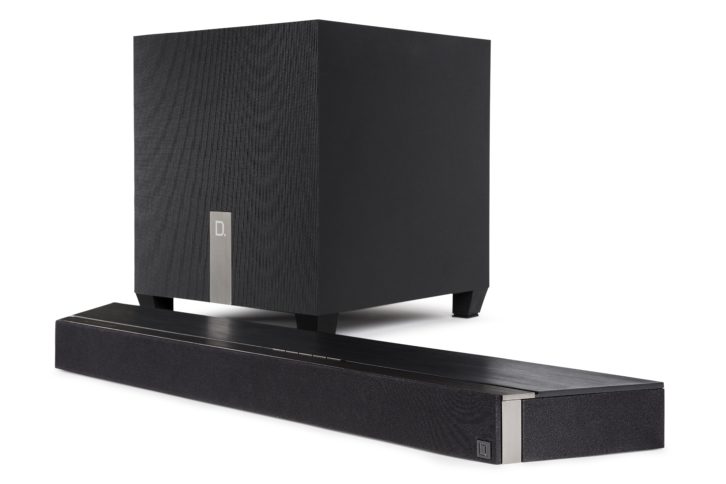
There are provisions — and a nice included template — for wall-mounting the bar, and I appreciated that the bar doesn’t use an external power supply that always complicates wall-mounting. It also uses a detachable power cable in-case it needs a reboot (never required during my use). While the bar certainly doesn’t call much attention to itself at just 26.5 inches total width, some people might find that it looks a bit out of place mounted beneath large flat panel displays. Even sitting beneath my 65-inch display, the bar seemed dwarfed, and it would seem downright minuscule beneath an 85-incher. Performance aside, it just looks like a bar that was designed to be paired with smaller displays.
As with most modern, eARC-equipped soundbars, installation is really a breeze. Definitive goes a step further by including a QR code in the packaging that takes you to a short video showing how to install it; perfect for any customers who want to give installation a shot on their own. There’s also a link to an online 85-page (!) owner’s manual that gives a deep dive into all the bar’s features. Really, the trickiest part of integrating a soundbar’s eARC connection with a TV has little to do with the soundbar itself, and more with making sure the output settings are set correctly in the TV.
Like many of you, I’ve been burned by the promise of how great HDMI ARC was going to be, and its brutal lack of reliability meant I basically stopped using it on installs. However, I have to say that eARC seems to have righted many of those wrongs, and actually seems to live up to the promise, with stable, reliable results. I used the eARC connection throughout my review, and never had any issues where it didn’t work or immediately connect. Beyond the improved stability, eARC’s big allure is that it has the bandwidth to pass lossless audio signals like Dolby TrueHD and DTS HD-Master, meaning you can enjoy the best sound the source is capable of delivering.
In addition to the eARC HDMI output, the bar has a single HDMI input that passes 4K HDR video (including Dolby Vision), a Toslink optical digital, and a 3.5mm analog mini-jack connection. There is also a USB connection for local audio files, though it is relatively awkward to access even with the bar just sitting on a tabletop, let alone wall-mounted, and is all but useless in practicality.
After the physical cable connections are made, the remainder of setup is done in the HEOS app (iOS and Android). There is an RJ45 Ethernet connection for hardwiring to the network, but, as most installs will likely be of the Wi-Fi variety, that’s what I used. The bar supports both 2.4 and 5 GHz Wi-Fi, and setup is quick and simple.
The HEOS app has really developed over the years and is now a compelling offering, especially when you talk about the ease of integrating audio from Denon and Marantz AVRs into a whole-home audio system. HEOS natively supports a large variety of streaming services, including Amazon Music, iHeartRadio, Pandora, Tidal, TuneIn, Deezer, Napster, SiriusXM, SoundCloud, Spotify, and Mood Mix, as well as streaming files across a local network, including high-res up to 24-bit/192 kHz and DSD up to 5.6 MHz.
If you don’t want to use HEOS for music streaming (though you should, and the HEOS app provides the means for performing firmware updates on the bar), the bar supports both Bluetooth and Apple AirPlay2.
Because it is a full-fledged HEOS product, you can add it to automation systems (Control4, Crestron, URC, ELAN) using the HEOS control drivers. This makes the Studio 3D Mini the first soundbar from Sound United to offer IP control. Adding it to my Control4 system took just a few clicks and then it was good to go. One minor quirk was that while the volume slider bar worked (and gave feedback) in my Control4 iOS app, the volume up/down/mute buttons did not.
Should HDMI CEC not work for controlling the bar’s volume, you can learn the volume commands from your TV/cable remote through the HEOS app. While there is no ability to repeat IR commands on to a TV should the bar block the signal, the bar sits so low it is unlikely to impede IR commands in most installs.
Like every other current Definitive offering, there is no microphone room calibration setup for the bar. The HEOS app does prompt you to specify if the bar is wall or cabinet mounted, incorporating EQ to adjust for boundary gain. You also get basic bass/treble adjustment along with a ±15-step subwoofer control.
You also can’t control the level or amount of the surround processing (you can select between Dolby and DTS Virtual:X on most 2.1- to 5.1-channel video content). Speaking of processing, Definitive told me that the bar features a full-fledged AVR DSP chipset, and the bar is capable of decoding and processing full lossless 7.1-channel Dolby TrueHD and DTS-HD Master audio. It also uses this DSP for Night mode, dialog adjustment in three levels, and Dolby Surround and DTS Virtual:X processing.
Multiroom Performance
To go with the review, Sound United provided a Denon Home 350 speaker so I could test the multiroom functions and capabilities of the system. But the joke was on them because I already had a HEOS Link and HEOS-capable Marantz AV8805 preamp! Of course, when PR wants to send more toys to play with, it would just be rude to decline…
The 350 is a standalone, full-range tabletop speaker that just requires a power connection to add audio into a separate area. For even more sound, two of them can be paired together to make a stereo pair. It also has cool, proximity sensing, capacitive touch controls on the top that light up as you reach for it, letting you choose from six different Quick Select music presets to quickly start a playlist or streaming station and adjust volume.
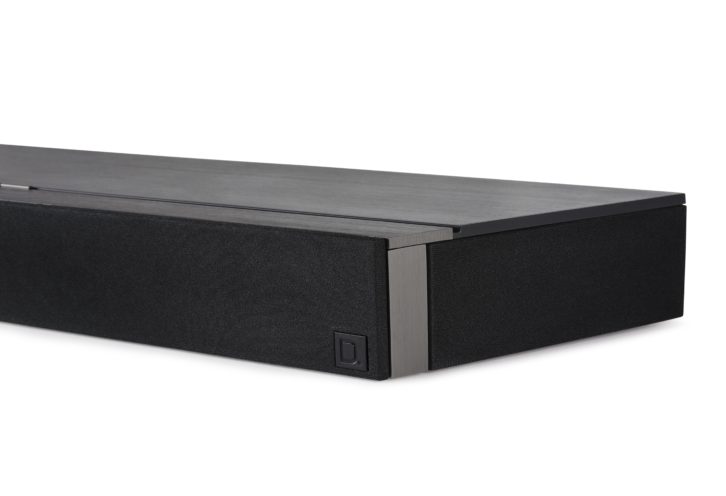
Once all of the speakers are added to the HEOS app, you navigate to the Home/Rooms tab where you can see what every area is currently playing and select the room you want to control. Grouping rooms together is as simple as dragging them together, and then audio syncs and starts playing.
One very cool feature is that you can select any source or input from any HEOS device for multiroom streaming. So the Dolby Atmos audio from the movie I’m watching on my Kaleidescape connected to the Studio 3D Mini can be selected and listened to in any other HEOS zone. This is a great feature if you’re having a movie or event party (think Super Bowl) where guests are likely to wander out of the main room, but want to still stay connected to the action wherever they are in the home.
Even when digitizing the audio output signal from my TV and streaming it — wirelessly — across the home to other speakers, there were no lip-sync delay issues with the Studio 3D Mini or discernible audio delay in the other rooms. That is impressive!
In Use
The Studio 3D Mini has a total of four 1×3-inch racetrack drivers, with two on the bar’s angled sides to expand the soundstage and two in the front, along with two front-firing 1-inch aluminum dome tweeters. These six-drivers comprise four channels, essentially front and rear left/right, for 4.1-channel performance with the subwoofer.
Yes, you read that correct; this Dolby Atmos-capable soundbar has no upfiring drivers for height/overhead information, and no dedicated center channel.
Given the opportunity to talk to one of the members of the 3D Mini’s design team, I asked why. They said that smaller formfactor bars are having a lot of success in the market, and the goal was to design a high-performance bar that delivered giant sound in a small size. Due to the bar’s size and design, installing upfiring drivers of any appreciable size wasn’t realistic, and the bar’s top didn’t have the space or size to offer the proper angle for these drivers. And with the bar’s front panel measuring just over 20 inches, the left and right driver array are so close together as to make a dedicated center channel unnecessary.
While the bar definitely delivers giant sound, it does have a fairly narrow soundstage. The side firing drivers certainly help to expand it, but I rarely felt like audio was expanding too far out to the sides. However, it does deliver a good bit of air and space around the presentation; almost like a spherical ball of sound that expands and emanates out from the bar. This sonic width and height illusion is certainly helped when the lights are down and you are watching video to accompany the audio, where sounds seem to stretch further into space.
This narrow sound is most noticeable with HEOS music, where the bar is locked into stereo mode (not letting you select Dolby Surround or DTS Virtual:X). Obviously, this is a more “accurate” presentation, but it does come at the expense of some soundstage. The tweeters really deliver the delicate high frequencies, such as metal brushes on cymbals. In Art Farmer’s “The Summer Knows” from New York Jazz Sessions, you can clearly hear the texture and differences in the brush strokes instead of it just sounding like a steady, one-note hiss.
I watched quite a bit of TV and multiple films on the bar, and it definitely delivers a ton of output. Dialog clarity was also exceptional, and the ability to quickly bump dialog up in three levels via the remote will be a welcome and helpful solution for those who have challenges hearing what is happening.
With surround-encoded material, you definitely get a far more cinematic experience. While it never really felt like sounds were happening overhead, they definitely extended well above the bar, seeming to emanate somewhere from above the top of the display. In Dunkirk, planes flying, water spouts from explosions, and water gurgling up in a flooding ship all had loads of height effect. When the president is being whisked away to safety in Marine One in London Has Fallen, the sounds from the rotor blades whir high-up in the soundstage.
We re-watched Kong: Skull Island to get ready for Godzilla vs. Kong, and the planes peeling offscreen during the opening dogfights showcased the bar’s ability to deliver width that reaches well outside the bar, as did the atmospheric jungle sounds that made the movie far more immersive.
As mentioned before, one thing that really helps the system punch above its size is the subwoofer, which consistently impressed while watching movies. Explosions in London Has Fallen were deep and authoritative, producing tactile bass. The sub also gave gunshots more dynamics and punch. Another perennial demo favorite, the first race from Ready Player One, was full of impressively layered sounds, with big, tactile bass I could feel in my seat, making for a much bigger sonic experience.
One minor complaint I had with the sub was that certain bass frequencies seemed to produce audible cabinet resonance, especially when played back at higher volumes. This was most noticeable on jazz music, caused by big, bass plugs. Things like the opening bass notes from Rebecca Pigeon’s “Spanish Harlem” or multiple tracks from Miles Davis’ Ascneseur pour l’enchafaud produced an audible cabinet vibration. This was rarely apparent during movies — likely because it was drowned out by so much other sonic mayhem going on — however, I did notice it during the plane crash heist scene in Tenet. (To be fair, Tenet has a bass-heavy mix that can give even the best subs a challenge.) The solution was to lower the volume or to drop the sub level a couple clicks, but it was worth noting.
While the bar — and HEOS — can technically support adding wireless rear speakers for a true surround experience, there is no current provision for doing so. Whether that ability is added at some point in the future remains to be seen.
Definitive Technology continues its legacy of delivering tons of value and performance with the Studio 3D Mini — a bar that delivers way more audio than its size suggests. With the lights out, the bar’s immense sonic output coupled with the sub more than makes up for its diminutive physical size. In fact, it reminded me a bit of those old Bose showroom demonstrations where they played audio with the lights down only to reveal that sound was coming out of tiny cubes and a concealed bass module. That would actually make a great showroom demo here; play some dynamic film clips with the Studio 3D Mini subtly sitting between a pair of tower speakers, and then when people say that sounds great but they don’t really want towers…bang! You reveal the tiny soundbar and ring up the sale.
https://www.DefinitiveTechnology.com; 800-228-7148
Kudos: Surprisingly full-range audio output; impressive volume levels; dialog intelligibility; HEOS integration
Concerns: So small it might look out of place with large displays; occasional sub cabinet resonance
Product Specs:
- Compact soundbar supporting object-based audio decoding, including Dolby Atmos and DTS:X
- Bar features four 1×3-inch mid/bass drivers and two 1-inch aluminum dome tweeters powered by six internal amplifiers; subwoofer features 8-inch driver powered by 100-watt amplifier
- HEOS multi-room audio streaming via iOS or Android; supports Amazon Music, iHeartRadio, Pandora, TIDAL, TuneIn, Deezer, Napster, SiriusXM, SoundCloud, Spotify, Mood Mix; network streaming including 192 kHz/24-bit high-resolution FLAC, WAV, ALAC, and DSD 2.8/5.6 MHz
- Wi-Fi (2.4 and 5 GHz), Apple AirPlay2, Bluetooth 4.2 wireless including A2DP
- Voice control via Amazon Alexa or Google Assistant; automation integration with Control4, Crestron, Josh, URC, and ELAN
- Connections Inputs: HDMI, 3.5mm analog audio, Toslink optical, USB Type-B, RJ45 Ethernet; Outputs: HDMI eARC, detachable power
Dimensions:
- Bar: 26.5 x 2 x 4.625-inches (WxHxD); Weight: 4.625 pounds
- Sub: 12.625 x 14 x 12.625-inches (WxHxD); Weight: 20.1 pounds



